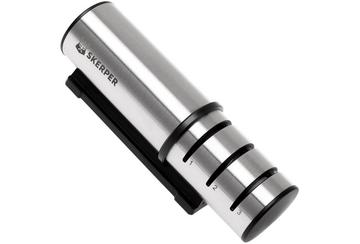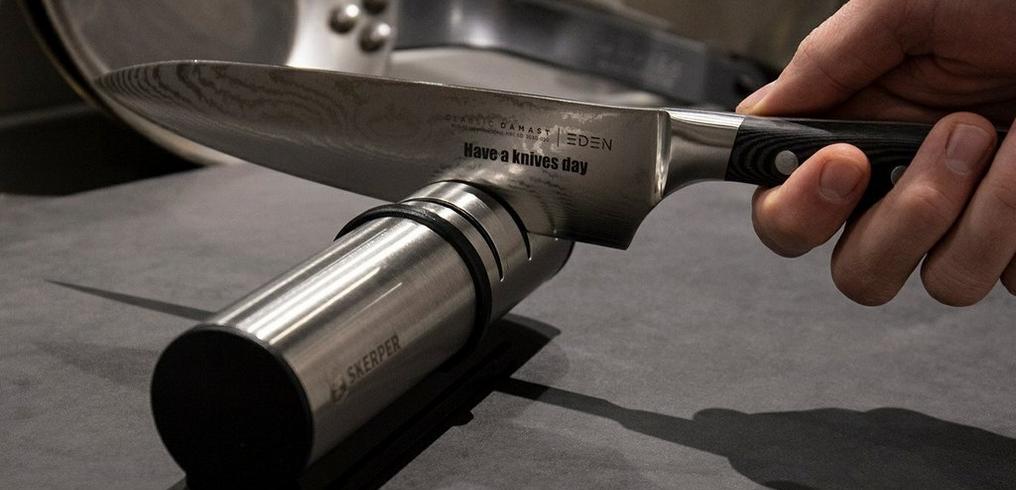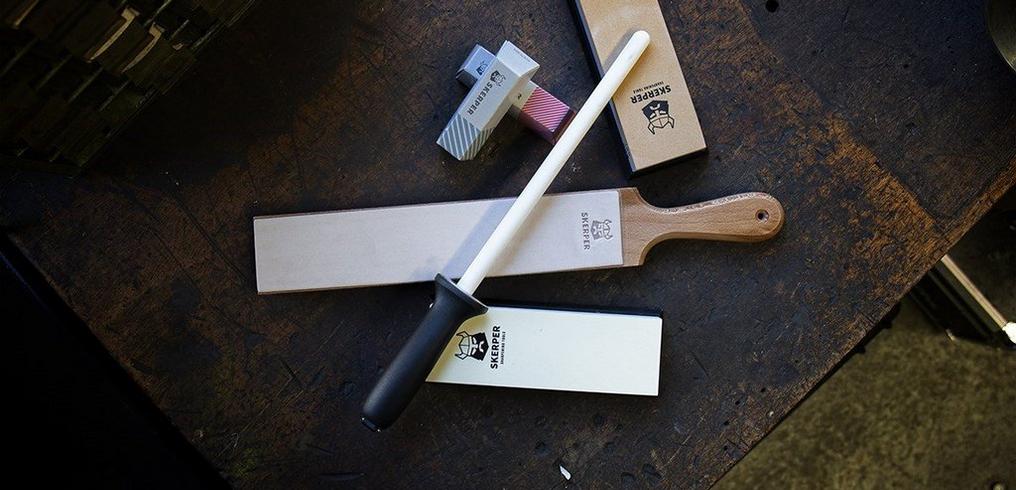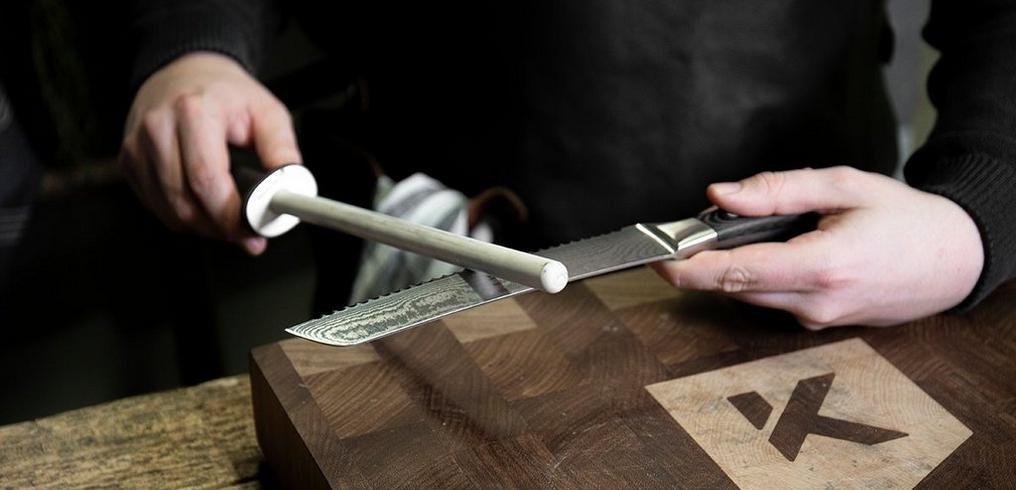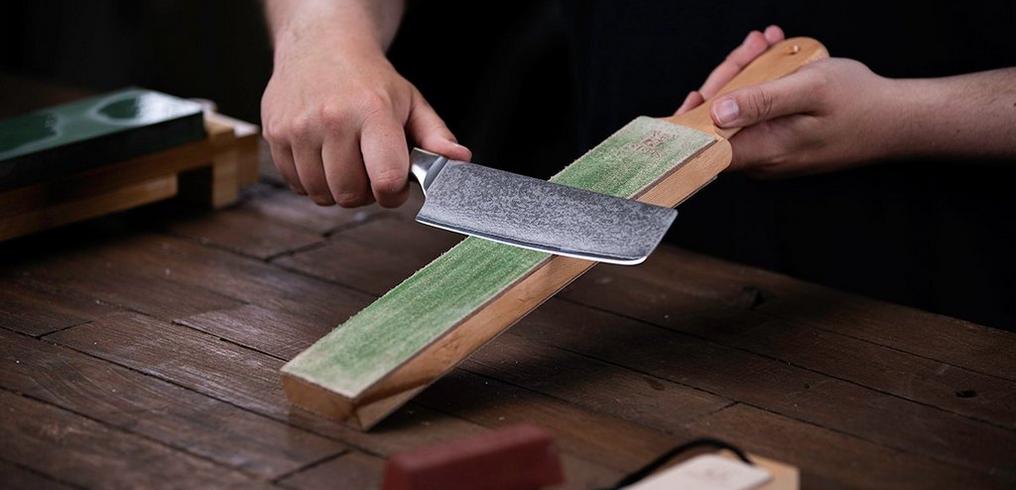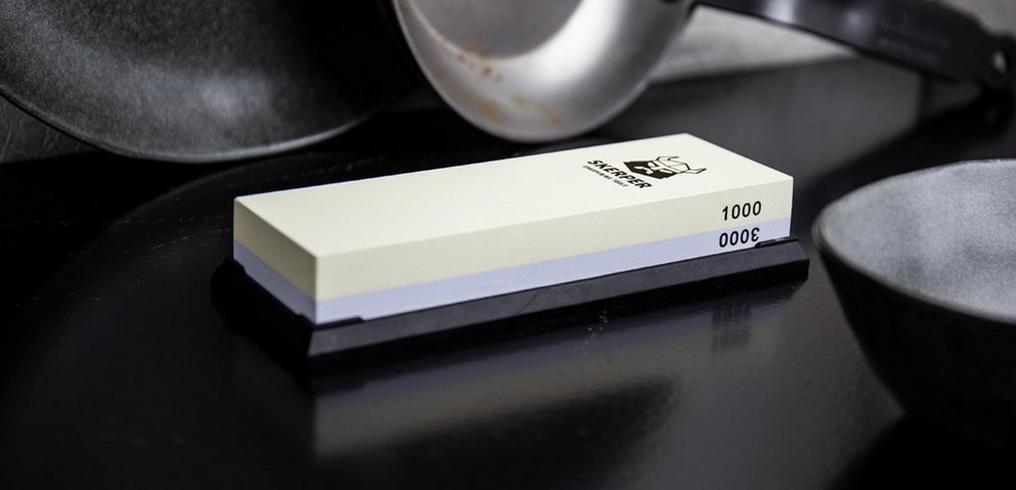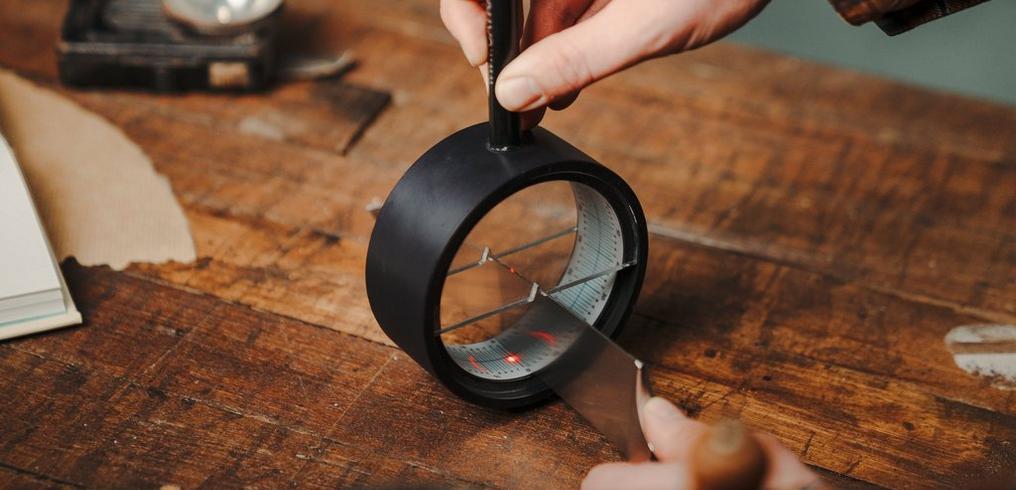Pull-through knife sharpeners put to the test
The pull-through sharpener is one of the easiest and fastest ways to sharpen your knives. The way your knife is guided ensures the right sharpening angle, one of the most important aspects when sharpening a knife. Perhaps the sharpening result is less razor-sharp than sharpening on a whetstone, but it is quick and easy. But which pull-through sharpener is right for you? We tested the most popular pull-through sharpeners for ease-of-use, feel, speed and resulting sharpness.
Testing the sharpness
To determine sharpness, we used the Edge-on-Up sharpness tester. This Edge-on-Up accurately measures the pressure it takes to cut through a small nylon thread. The Edge-on-Up only tests a small part of the blade. That is why we have tested each blade on 6 different spots. The average counts as the result of the sharpness test. Read more about the Edge-on-Up here.
We carried out the test with the Eden Classic Damast chef's knife. This is a popular knife, but it's also an average chef's knife like the ones most people will have at home.
To keep the test as fair as possible, we started each test with a fixed sharpness of 600 BESS. It is typically around this level of sharpness that a knife could use some sharpening. To achieve this sharpness (or rather bluntness) for each test, we passed a ceramic sharpening steel at a 90-degree angle over the edge of the knife until it had the desired bluntness.
We took five different knife sharpeners and used them under similar conditions, following the manufacturer's instructions. We did continue sharpening until we couldn't get the knife any sharper.
Minosharp Plus 3
| Type | This is a water sharpener. It sharpens your knife in three phases, using ceramic wheels. |
|---|---|
| Picture of cutting edge | 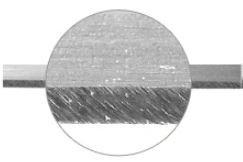 |
| Sharpness | The Minosharp sharpener provided the best result of all sharpeners in this test. The picture shows a nice V-shaped edge, smoothly sharpened and polished. Because of this high cut V-shape, the knife stays sharp longer than it would otherwise. |
| Sharpening speed | We used a total of 15 minutes to sharpen the knife through all three phases with the Minosharp sharpener. |
| Video | Click here to look at the video. |
| Price | |
| Overall rating | Without a doubt, the results of the Minosharp were sharpest and best of all knife sharpeners which we tested. It takes a little longer to reach a sharp edge than with some other sharpeners, also you need to add water. But if you want your knives to cut well, this is the choice to make for you. |
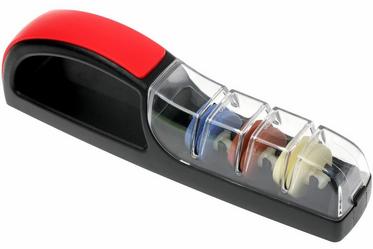
Chef's Choice 460
| Type | The electrical sharpening machine Chef's Choice 460 has diamond sharpening discs in 2 different grits |
|---|---|
| Picture of the cutting edge | 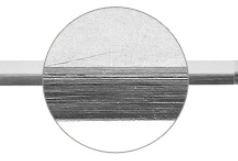 |
| Sharpness | The sharpness attained after going through both phases can be called reasonable. However, if you prefer working with truly sharp blades, this edge may dissapoint you. The picture shows clearly the signs of sharpening along the edge. |
| Sharpening speed | We used 20 minutes to sharpen the knife with this electrical sharpener. |
| Video | Click here to watch the video. |
| Price | Discontinued. Check all Chef's Choice products. |
| Overall rating | This Chef's Choice model is a very light type of electrical sharpener. Actually it doesn't score highest in any of the categories. Not pricing, speed or results. |
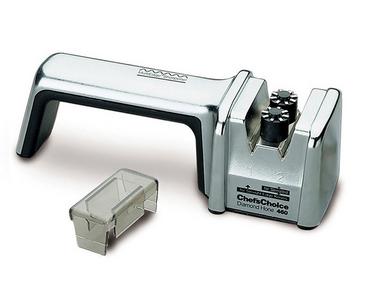
Vulkanus Standard
| Type | The Vulkanus sharpener uses spring action sticks made of extremely hard carbide. The sharpener is available in a stainless steel or plastic version. |
|---|---|
| Picture of the cutting edge | 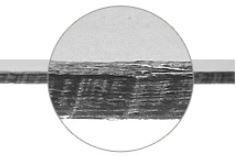 |
| Sharpness | Coarse sharpening on the Vulkanis is done with the knife pointing down and the fine sharpening with the knife point up. If you use it correctly it will put a good edge on your knife. However, when using the knife you will find its blunts quicker than when it's sharpened with, for example, the Minosharp. The cause of this can be seen in the picture of the edge; you can still see little burrs on the edge. |
| Sharpening speed | We used three minutes to sharpen the blade with the Vulkanus sharpener. |
| Video | Click here to check out the video. |
| Price | |
| Overall rating | The Vulkanus enables you to effectively sharpen a very blunt knife within a few minutes. Quick results are definitely something the Vulkanus excels in. A disadvantage is that the grinding is very coarse, which causes a lot of material loss. |

Wüsthof 4343
| Type | This Wüsthof sharpener has two ceramic wheels. |
|---|---|
| Picture of the cutting edge | 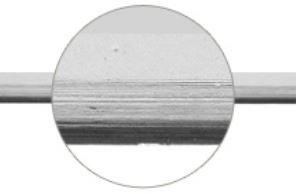 |
| Sharpness | The result is quite dissapointing. After more than 40 minutes of sharpening, we still did not have a satisfying result. The picture also shows that hardly any material was removed. |
| Sharpening speed | We quit sharpening after 40 minutes |
| Video | Click here to check out the video. |
| Price | Discontinued. Check all Wüsthof sharpening products. |
| Overall rating | Unfortunately this sharpener seems to fail at what a sharpener is made for; sharpening your knives. |

Zwilling Twinsharp
| Type | The Twinsharp sharpener has the ceramic wheels positioned in a line. This means that, with each move, you go through both phases of sharpening. |
|---|---|
| Picture of cutting edge |  |
| Sharpness | When pulling the knife through the sharpener, we heard a scraping noise. The picture shows that the knife was sharpened very coarsely and the edge finish isn't smooth. Cutting through paper is like using a serrated knife. It's quite sharp. |
| Sharpening speed | Because of the 2-in-1 phase the Twinsharp sharpens very quickly. We were done in two minutes. |
| Video | Click here to check out the video. |
| Price | |
| Overall rating | This sharpener excels in sharpening speed. But it's also vert rough hewn and removes a lot of material. Because there is no seperate polishing phase, it is very hard to achieve the desired result. The edge is less sharp then one coming from the Vulkanis. It is the most affordable choice. |

Zwilling Twinsharp Select
| Type | This Zwilling sharpener has 2 phases. Phase 1 uses carbide wheels. Phase 2 is for polishing on ceramic wheels. |
|---|---|
| Picture of cutting edge | 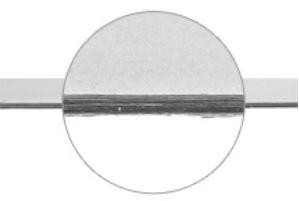 |
| Sharpness | The sharpening wheels of the Twinsharp select are the same as those in the standard Twinsharp. However, in this sharpening system the phases are split up. This results in a slightly finer edge. Despite this, it is still hard to create a truly sharpe edge with this sharpener. We can get the edge to an average level of sharpness, but are hardly impressed with the results. |
| Sharpening speed | Three minutes. |
| Video | Click here to check out the video. |
| Price | |
| Overall rating | In our opinion the Twinsharp Select, made of stainless steel has the most attractive design of all the sharpeners used for this test. The results are decent, but not well enough to really provide a pleasant cuttnig experience. |

- 1
Skerper Basic pull-through knife sharpener, SM001
In stock193,00 kr. - 2
Vulkanus Professional VG2 knife sharpener
In stock1.255,99 kr. - 3
Chef's Choice ProntoPro 4643, knife sharpener
Not available685,00 kr. - 4
Zwilling J.A. Henckels TwinSharp Select Knife Sharpener
In stock266,99 kr.300,00 kr. - 5
DMT Simple Sharp pull through sharpener
In stock249,49 kr.
- 1
Skerper Basic pull-through knife sharpener, SM001
The Skerper Basic pull-through sharpener is the cheapest pull-through sharpener in this test. It has three sharpening stages. One coarse diamond-coated sharpening stone in step 1, a medium diamond-coated sharpening stone in step 2 and a fine ceramic sharpening stone in step 3. The sharpener feels sturdy and there's enough space to comfortably hold on to it. The first thing we noticed is that the first two sharpening stages feel and sound like they're very coarse. This is not unusual for diamond-coated sharpening stones, as they need to be pre-sharpened. The level of coarseness did make these stages very quick. After a few pulls through the machine, we already felt that we could move to the next phase. Same thing for stage 2, quite coarse and quick results. The last step was the ceramic sharpening stone. This felt like a pretty steep step up in grain size compared to the coarse and medium diamond-coated sharpening stones. The ceramic sharpening stone felt very fine in grit size. However, this step did feel slightly wobblier than the other two. It took some more effort to keep the knife at the right angle.
Results:
We got average results with the 306 BESS. That is more or less the sharpness of the knife when it's fresh out the box. A good pull-through sharpener for a good price!
In stock193,00 kr. - 2
Vulkanus Professional VG2 knife sharpener
After the cheapest, we tested the most expensive pull-through sharpener. De Vulkanus Professional VG2. This sharpener only has one sharpening stage, but it automatically adjusts the sharpening angle to your knife. This pull-through sharpener uses carbide as its sharpening material. First of all, look at it! It is a pull-through sharpener that you can proudly leave on your counter. The sharpener is sturdy, you don't need to hold on to it when you're sharpening. What stands out is the sharpening feel. It is very subtle, and the removal of material doesn't seem too bad. This is fine if you're sharpening a slightly blunt knife, but if your knives are very blunt, it would take a long time before you get them sharp again. During our test, this sharpener was already definitely slower than the others. But the sharpness does not disappoint!
Results:
After sharpening the knife, we got an average sharpness of 294 BESS.
In stock1.255,99 kr. - 3
Chef's Choice ProntoPro 4643, knife sharpener
If you are familiar in the world of pull-through sharpeners, you have probably heard of Chef's Choice. This pull-through sharpener has three sharpening stages, but in a slightly different way than the previously mentioned sharpeners. It has one slot for Japanese kitchen knives with a sharpening angle of 15 degrees. And another for European kitchen knives with a sharpening angle of 20 degrees. The third slot has a little diamond-coated sharpening stones, with a fine grit size. This sharpener has a big and comfortable handle. Since we're sharpening a European chef's knife, we only used the second and third slots. What stood out was the grip the sharpening stones have on the blade. It's not at all wobbly. However, we were a little concerned about the material of the sharpening stones. The second slot felt pretty coarse. The final stage is finer, but it is still a diamond-coated sharpening stone. Diamond-coated sharpening stones are generally coarser than a ceramic sharpening stones. But it sharpens quickly, that's for sure. And even though it felt very coarse, the results did not disappoint!
Results of the sharpness test
After sharpening, the knife had a sharpness of 228 BESS.
Not available685,00 kr. - 4
Zwilling J.A. Henckels TwinSharp Select Knife Sharpener
The next pull-through sharpener is from the famous knife brand Zwilling. This sharpener has two stages. This first step features a little steel wheel, which you can use to hone your kitchen knife, similar to a honing steel. The second step has a fine ceramic sharpening stone for the actual sharpening. This sharpener has a stylish and sleek design, but did it pass the test? It took us a few tries before we got the knife in the right position and before we got the movement right. After five minutes, we got the hang of the technique and sharpening went smoothly. This sharpener does make more sound than the other sharpeners we tried. The metal slot is comparable to a honing steel, so this step is not suitable for really blunt knives. But the ceramic slot sharpens quickly. What's great about this sharpener is its price and its looks. All in all, a great product!
Results:
After sharpening, the knife had an average result of 288 BESS.
In stock266,99 kr.300,00 kr. - 5
DMT Simple Sharp pull through sharpener
DMT is known for their diamond-coated sharpening products. The DMT SimpleSharp combines DMT's high-quality diamond-coated sharpening stones with the convenience of a pull-through sharpener. The sharpening stones in the pull-through sharpener can be replaced with any other sharpening stones from DMT's W7 series. This gives you a lot of different sharpening stones to choose from! Sold separately, unfortunately. We tested it with the sharpening stones that are included with the SimpleSharp: the DMT W7F fine sharpening stones. It was a little difficult to hold on to the sharpener. We found the black parts with grip a bit oddly placed and you have to be careful not to cut your fingers. We held it at the bottom and that seemed to work okay. The pull-through sharpener is made of plastic, but it feels sturdy. The sharpening feel is nice and you get quick results. But the main advantage is that there are different sharpening stones available for this sharpener!
Results:
After sharpening, the knife had an average result of 280 BESS.
In stock249,49 kr.
Conclusion
A pull-through knife sharpener is easy to use and definitely a good option for those who want sharp knives, if convenience and speed are a high priority with sharpening. The true ‘razor edge freaks’ will have to take a look Japanese water stones. These give you the ultimate razor-sharp edge on any blade. The pull-through sharpeners we tested all sharpen your knives and offer good results. The speed, ease-of-use and feel do differ per product. Each sharpener has its own pros and cons that you can consider before making your choice.
